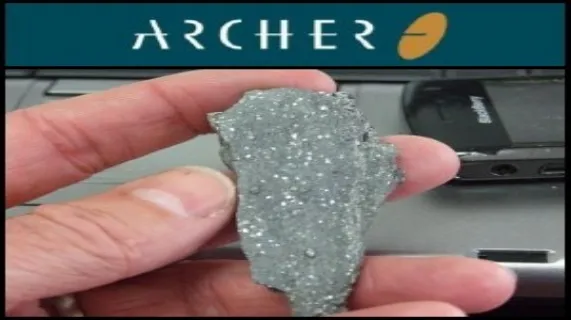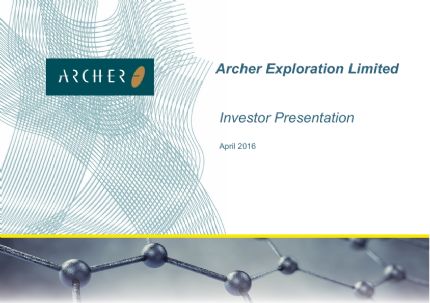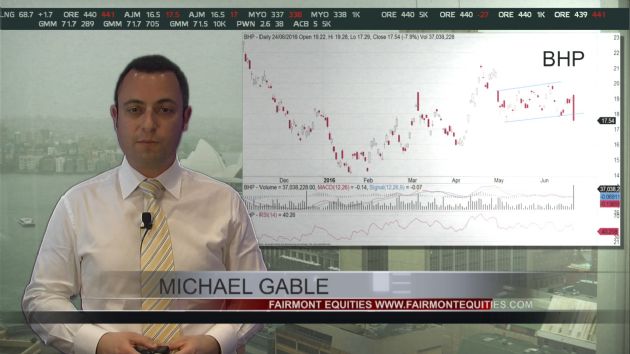
Archer Exploration Limited (ASX:AXE) Recorded Several Coarse Flake Graphite Occurrences on Wildhorse Plains
Perth, June 21, 2011 AEST (ABN Newswire) - Archer Exploration Limited ( ASX:AXE) is pleased to announce that the Eyre Peninsula has long been explored for its uranium and base metal potential. Many companies including Kerr McGee, Esso, BHP (
ASX:AXE) is pleased to announce that the Eyre Peninsula has long been explored for its uranium and base metal potential. Many companies including Kerr McGee, Esso, BHP ( NYSE:BHP) (
NYSE:BHP) ( ASX:BHP) and Shell (
ASX:BHP) and Shell ( NYSE:RDS.A) explored the area and reported graphitic rocks.
NYSE:RDS.A) explored the area and reported graphitic rocks.
Historic electro-magnetic surveys identified numerous conductors which when drilled recorded graphitic rocks. Graphite was targeted as it was considered a favourable host for Alligator River style uranium mineralisation.
Graphite on Wildhorse Plains
Literature searches and ground inspections for EL4693 Wildhorse Plains has identified a number of highly prospective graphite occurrences including the identification of coarse flake graphite at Campoona, Campoona South, A405, Wilklow and Calkookra. At Ben Buy graphite to 0.1mm (US 140 mesh) is recorded. In addition abundant graphite is recorded at High Bluff (Grid 2), Mt Shannan and Cock Hill.
Archer through a farm-in agreement has earned the rights to 100% of the minerals other than uranium on EL4693.
Coarse Flake Graphite Occurrences EL4693 Wildhorse Plains
1. Campoona
In the mid 1980s airborne electro-magnetic surveys were conducted as part of exploration focused on base metals. A highly conductive graphitic schist over 4km long was identified adjacent to the Lower Middleback Jaspilite in the Campoona Hill region. A small historic shaft exists on the graphitic schist however literature searches have failed to find production records.
Other elongate EM conductors, which are parallel to the graphitic schist were also thought to be graphitic in origin. This was confirmed by drilling by ESSO where 3 holes were drilled at High Bluff.
In 1991 PIRSA received a petrology report on the graphite. The graphite displayed a limited range of 0.1mm to 0.3mm with an average flake size of 0.2mm.
2. Campoona South
At the southern end of the Campoona EM anomalies there is an outcrop of graphite that has visible coarse flake graphite to 1mm. The outcrop of high grade crystalline graphite was sampled and returned 25.4% Total Carbon.
3. A405
Graphite was reported in drill holes as a part of uranium exploration in 1968 by Kerr McGee. These drill holes were sampled by Archer and reported 16.5m @ 0.32g/t Au and 7.43 g/t Ag (September 2010 quarterly).
- Hole A405/2 graphite flakes were reported from 32 to 56 metres, within altered dolomites.
- Hole A405/3 medium crystalline graphite was reported over a few metres.
- Hole A405/3A common graphite flakes were reported from 28 to 41m downhole.
- Hole A 405/3B trace graphite flake from 41 to 52m (EOH)
Archer will recover samples from the hole to examine the quality of the graphitic material.
4. Wilklow
Graphite was reported during exploration for uranium. Historically a sample of graphitic schist was taken from the surface that "yielded 4.25% of flake graphite which assayed 39.25% carbon." It was believed at the time (pre 1952) that grinding to minus 200 mesh (74 micron) would not generate an economic product.
Two holes were drilled in 1952, both intersected graphite within clay-rich weathered quartzite, the only comment was recovery was poor and graphite appeared fine.
One hole was drilled in 1991 to test a IP/resistivity anomaly intersected high grade metamorphic rocks with graphite. The IP anomaly was attributed to the graphite.
One sample submitted for petrology at the time (1990) contained graphite, it was reported "moderate amounts of graphite forming well developed flakes up to 0.5mm in length."
The metamorphic grade of these rocks is conducive to graphite flake development.
5. Calkookra
Campoona was a historic underground copper mine. In 1968 regional exploration for uranium identified graphite in an exploration drill hole. Although no qualitative work was performed on the graphite, the metamorphic grade of the surrounding rocks (mylonite and amphibolite) provides encouragement for coarse flake development.
A copper enriched sample was submitted for petrology in 1983, it was reported as having 5% graphite with flakes of approximately 0.3mm in length.
Medium Flake Graphite Occurrence on EL4693 Wildhorse Plains
Ben Buy
In 1980 graphitic schists were identified within altered dolomite units during exploration for uranium. IP surveys were able to trace out the graphitic units.
One petrology sample was collected by PIRSA from a trench in 1991 and recorded graphite flakes in the range 0.05 to 0.1mm.
Other Graphite Occurrences on EL4693 Wildhorse Plains
In addition to the coarse and medium graphite recorded above, three other graphite bodies have been identified at Wildhorse Plains. The grain size of these deposits is yet to be determined.
High Bluff (Grid 2)
High Bluff was tested for base metal mineralisation by ESSO with 3 + 150m holes spaced at 200m apart. Graphitic schist was reported in all holes. The holes lie on the southerly extent of one of the Campoona EM conductors.
Drill hole logs report;
- Hole G2P-1 0 to 147m Biotite quartz, muscovite, feldspar, garnet schist/micro gneiss with varying graphite, pyrite and magnetite as accessories.
- Hole G2P-2 0 to 161m Biotite quartz, muscovite, feldspar graphite schist, intruded by pegmatites.
- Hole G2P-3 0 to 150m Biotite quartz schist with varying feldspar, garnet graphite, chlorite and pyrite, with minor pegmatites.
No petrological or qualitative work was performed on the graphite occurring in the drill holes. Within the drill logs high grade metamorphic minerals such as sillimanite and cordierite as well as zone of migmatite provide encouragement for graphitic flake development.
Mt Shannan
This area comprises a number of historical drill intersections as well as rock chip sampling of graphitic schists associated with the Mt Shannan Iron Formation. Outcrops were identified during historical exploration for gold, base metals and uranium.
Archer will attempt to recover any historical core available from PIRSA with the intention of performing petrology to identify the graphite quality.
New Tenement Application
Archer applied for a new mineral tenement covering prospective ground west of Wildhorse Plains.
About Graphite
Graphite and diamonds are the only two naturally formed polymers of carbon. Graphite is an excellent conductor of heat and electricity and has the highest natural strength and stiffness of any material. It maintains its strength and stability to temperatures in excess of 3,600 degree and is very resistant to chemical attack. At the same time it is one of the lightest of all reinforcing agents and has high natural lubricity.
Traditional Uses for Graphite
Traditional demand for graphite is largely tied to the steel industry where it is used as a liner for ladles and crucibles, as a component in bricks which line furnaces and as an agent to increase the carbon content of steel. In the automotive industry it is used in brake linings, gaskets and clutch materials. Graphite also has a myriad of other uses in batteries, lubricants, fire retardants, and reinforcements in plastics.
Industrial demand for graphite has been growing at about 5 per cent per annum for most of this decade due to the ongoing industrialization in China, India and other emerging economies.
Rapidly Growing Demand for Graphite from "Green Initiatives"
Graphite demand is surging in response to a number of green initiatives including lithium-ion batteries, fuel cells, solar energy, semi-conductors, and nuclear energy. Many of these applications have the potential to consume more graphite that all current uses combined.
The market for graphite exceeds one million tonnes per year with some 600,000 tonnes produced as amorphous graphite powder and 400,000 tonnes of various sized crystalline flake graphite.
China produces around 80 per of the world's graphite supply. Approximately 70% of Chinese production is graphite powder termed amorphous graphite. Chinese graphite is declining in quality and costs are increasing due to the effects of high grading and to tightening labor and environmental standards. The majority of Chinese graphite mines are small and many are seasonal. Easily mined surface oxide deposits are being depleted and mining is moving into deeper and higher cost deposits. China now has a 20% export duty on graphite, as well as a 17% VAT, and has instituted an export licensing system to ensure supply to its domestic economy including its burgeoning steel industry which internally consumes a great deal of graphite. These measures are creating supply concerns for the rest of the world.
The demand for graphite is surging as the world seeks newer and better energy storage solutions to provide clean portable energy, alternative fuel for the automotive industry (the emergence of hybrid electric vehicles) and energy storage solutions for green energy initiatives such as solar energy.
Graphite is in strong demand for use lithium-ion batteries. Lithium-ion batteries are smaller, lighter and more powerful than traditional batteries. They have no memory effect and a very low rate of discharge when not in use. As a result, most portable consumer devices such as laptops, mobile phones, MP3 players and digital cameras use lithium-ion batteries. These batteries are now also being used in power tools. While this market is growing, the batteries are small and the resultant demand for metal is relatively small. Graphite demand in lithium-ion batteries was estimated at 44,000 tonnes in 2008 or about 10 per cent of the flake market.
However, lithium-ion batteries are now being used in hybrid electric vehicles ("HEV"), plug in electric vehicles ("PEV") and all electric vehicles ("EV") where the batteries are large and the potential demand for graphite huge. There is twenty times more graphite that lithium in lithium-ion batteries.
While batteries store electrical energy for subsequent use, fuel cells also generate electricity through chemical reactions and therefore need to be periodically "refueled". Fuel cells can be used in both stationary and mobile applications. Fuel cells use substantially more graphite than lithium ion batteries. Fuel cells have no moving parts, are long lasting, low maintenance, quiet and reliable and produce little or no waste products.
Graphite use is also expected to rise sharply due to its growing use in Pebble Bed Nuclear Reactors ("PBNR"). These reactors are small, modular nuclear reactors. The fuel is uranium imbedded in graphite balls the size of tennis balls. These reactors have a number of advantages over large traditional reactors namely:
Lower capital and operating costs. They use inert gases rather than water as coolants. Therefore, they do not need the large, complex water cooling systems of conventional reactors and the inert gases do not dissolve and carry contaminants. These reactors cool naturally when shut down. The reactors operate at higher temperatures leading to more efficient use of the fuel and they can directly heat fluids for low pressure gas turbines.
The first prototype is operating in China and the country has firm plans to build 30 by 2020. China ultimately plans to build up to 300 Gigawatts of capacity and PBNRs are a major part of the strategy.
Small, modular reactors are also very attractive to small population centers or large and especially remote industrial applications. Companies such as Hitachi are currently working on turn-key solutions. Researchers at West Virginia University estimate that 500 new 100GW pebble reactors will be installed in the US by 2020 with an estimated graphite requirement of 400,000 tonnes. This alone is equal to the world's current annual production of flake graphite without taking into account pebble reactor demand from the rest of the world, growing industrial demand and growing demand from other applications such as lithium-ion batteries. It is estimated that each pebble reactor will require 300 tonnes of graphite at start up and 60-100 tonnes per year to operate.
Surging Demand Pushes Graphite Prices
Surging demand has and continues to drive graphite prices higher. Prices appear set for sustained growth on the back of surging demand.
The next steps
Archer will recover historic drill intervals to quantify the quality of graphite reported and to enable the multitude of graphite occurrences to be ranked based on potential resource size, carbon grade and flake size. Drilling will then target the best of the Wildhorse Plains graphite occurrences as part of a larger drill program involving resource drilling at Sugarloaf.
For the complete Archer Exploration announcement including figures and tables, please refer to the following link:
http://www.abnnewswire.net/media/en/docs/183446.pdf
Contact
Mr Greg English
Chairman
Archer Exploration Limited
Tel: +61-8-8272-3288
Mr Gerard Anderson
Managing Director
Archer Exploration Limited
Tel: +61-8-8272-3288
Email: info@archerexploration.com.au
http://www.archerexploration.com.au
| ||
|



















